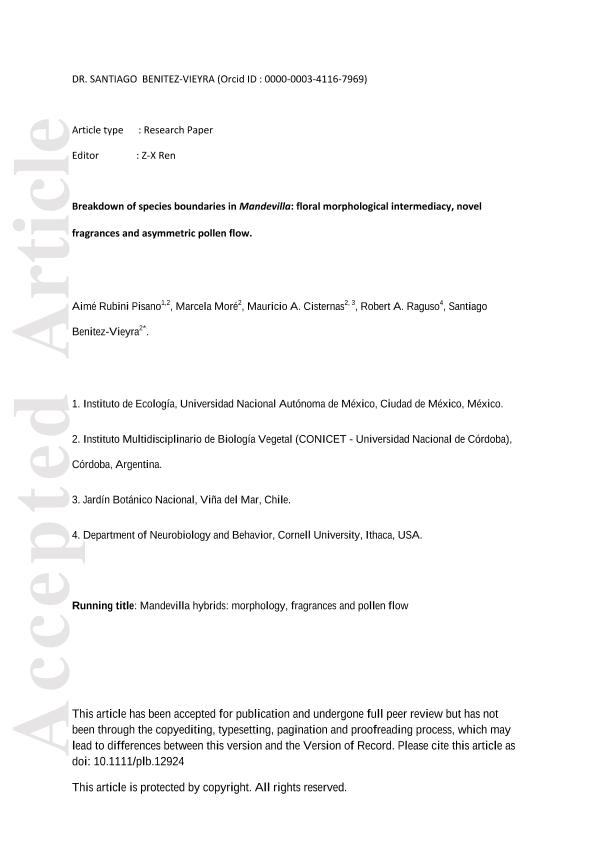Mostrar el registro sencillo del ítem
dc.contributor.author
Rubini Pisano, María Aimé

dc.contributor.author
More, Marcela

dc.contributor.author
Cisternas, Mauricio

dc.contributor.author
Raguso, Robert A.
dc.contributor.author
Benitez-Vieyra, Santiago Miguel

dc.date.available
2020-07-16T15:45:02Z
dc.date.issued
2018-10
dc.identifier.citation
Rubini Pisano, María Aimé; More, Marcela; Cisternas, Mauricio; Raguso, Robert A.; Benitez-Vieyra, Santiago Miguel; Breakdown of species boundaries in Mandevilla: Floral morphological intermediacy, novel fragrances and asymmetric pollen flow; Wiley Blackwell Publishing, Inc; Plant Biology; 21; 10-2018; 206-2015
dc.identifier.issn
1435-8603
dc.identifier.uri
http://hdl.handle.net/11336/109377
dc.description.abstract
Phenotypic intermediacy is an indicator of putative hybrid origin, and has provided the main clues to discovering hybrid plants in nature. Mandevilla pentlandiana and M. laxa (Apocynaceae) are sister species with clear differences in floral phenotype and associated pollinator guilds: diurnal Hymenoptera and nocturnal hawkmoths, respectively. The presence of individuals with intermediate phenotypes in a wild population raises questions about the roles of visual and olfactory signals (i.e. corolla morphology and floral fragrances) as barriers to interbreeding, and how the breakdown of floral isolation occurs.We examined phenotypic variation in a mixed Mandevilla population analysing the chemical composition of floral fragrances, characterizing floral shape through geometric morphometrics and assessing individual grouping through taxonomically relevant traits and an unsupervised learning algorithm. We quantified the visitation frequencies of floral visitors and tracked their foraging movements using pollen analogues.The presence of morphologically intermediate individuals and pollen analogue movement suggested extensive hybridization between M. laxa and M. pentlandiana, along with asymmetrical rates of backcrossing between these putative hybrids and M. laxa. Floral volatiles from putative hybrid individuals showed a transgressive phenotype, with additional compounds not emitted by either parental species.Our results suggest the presence of a hybrid swarm between sympatric M. pentlandiana and M. laxa and indicate that initial hybridization events between these parental species are rare, but once they occur, visits between putative hybrids and M. laxa are common and facilitate continued introgression.
dc.format
application/pdf
dc.language.iso
eng
dc.publisher
Wiley Blackwell Publishing, Inc

dc.rights
info:eu-repo/semantics/openAccess
dc.rights.uri
https://creativecommons.org/licenses/by-nc-sa/2.5/ar/
dc.subject
APOCYNANCEAE
dc.subject
FLORAL FRAGRANCES
dc.subject
GEOMETRIC MORPHOMETRY
dc.subject
PHENOTYPIC INTERMEDIACY
dc.subject
MADEVILLA
dc.subject
POLLINATION
dc.subject.classification
Biología

dc.subject.classification
Ciencias Biológicas

dc.subject.classification
CIENCIAS NATURALES Y EXACTAS

dc.subject.classification
Ecología

dc.subject.classification
Ciencias Biológicas

dc.subject.classification
CIENCIAS NATURALES Y EXACTAS

dc.title
Breakdown of species boundaries in Mandevilla: Floral morphological intermediacy, novel fragrances and asymmetric pollen flow
dc.type
info:eu-repo/semantics/article
dc.type
info:ar-repo/semantics/artículo
dc.type
info:eu-repo/semantics/publishedVersion
dc.date.updated
2020-07-13T16:09:56Z
dc.identifier.eissn
1438-8677
dc.journal.volume
21
dc.journal.pagination
206-2015
dc.journal.pais
Reino Unido

dc.journal.ciudad
Londres
dc.description.fil
Fil: Rubini Pisano, María Aimé. Universidad Nacional Autónoma de México; México. Consejo Nacional de Investigaciones Científicas y Técnicas. Centro Científico Tecnológico Conicet - Córdoba. Instituto Multidisciplinario de Biología Vegetal. Universidad Nacional de Córdoba. Facultad de Ciencias Exactas Físicas y Naturales. Instituto Multidisciplinario de Biología Vegetal; Argentina
dc.description.fil
Fil: More, Marcela. Consejo Nacional de Investigaciones Científicas y Técnicas. Centro Científico Tecnológico Conicet - Córdoba. Instituto Multidisciplinario de Biología Vegetal. Universidad Nacional de Córdoba. Facultad de Ciencias Exactas Físicas y Naturales. Instituto Multidisciplinario de Biología Vegetal; Argentina
dc.description.fil
Fil: Cisternas, Mauricio. Jardín Botánico Nacional; Chile. Consejo Nacional de Investigaciones Científicas y Técnicas. Centro Científico Tecnológico Conicet - Córdoba. Instituto Multidisciplinario de Biología Vegetal. Universidad Nacional de Córdoba. Facultad de Ciencias Exactas Físicas y Naturales. Instituto Multidisciplinario de Biología Vegetal; Argentina
dc.description.fil
Fil: Raguso, Robert A.. Cornell University; Estados Unidos
dc.description.fil
Fil: Benitez-Vieyra, Santiago Miguel. Consejo Nacional de Investigaciones Científicas y Técnicas. Centro Científico Tecnológico Conicet - Córdoba. Instituto Multidisciplinario de Biología Vegetal. Universidad Nacional de Córdoba. Facultad de Ciencias Exactas Físicas y Naturales. Instituto Multidisciplinario de Biología Vegetal; Argentina
dc.journal.title
Plant Biology

dc.relation.alternativeid
info:eu-repo/semantics/altIdentifier/url/http://doi.wiley.com/10.1111/plb.12924
dc.relation.alternativeid
info:eu-repo/semantics/altIdentifier/doi/http://dx.doi.org/10.1111/plb.12924
Archivos asociados
